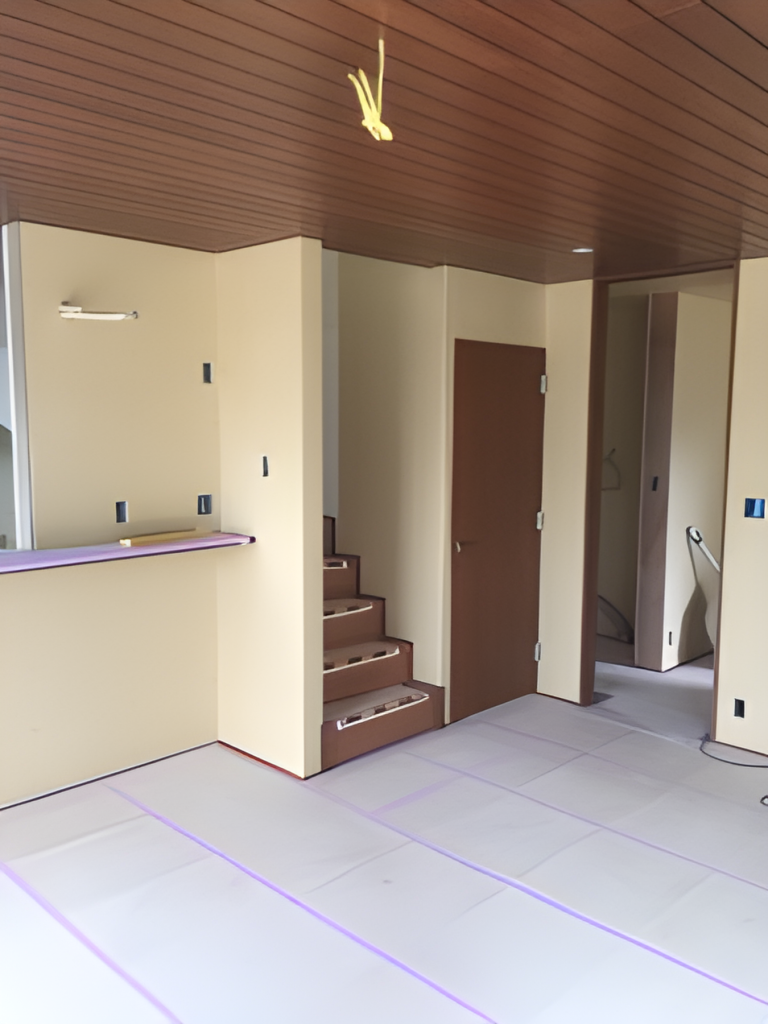Ceilings Deserve More Attention Than We Give Them
When you walk into a room, your eyes naturally go to the walls, the furniture, maybe the windows. The ceiling is too often treated as dead space, painted white and forgotten. Yet a subtle shift overhead changes everything beneath it. I’ve spent years working in rural Japan, restoring farmhouses and building new homes, and time and again I’ve seen how a veneered ceiling reshapes a room’s entire atmosphere.
The Tradition of Kibari-Tenjou
In Japan, there’s a practice called kibari-tenjou, which literally means a wood-panel ceiling. Sometimes it’s solid wood, sometimes veneer over MDF, and sometimes it’s a printed plastic sheet that imitates wood grain. Each has its place. For the project in front of me, I chose the plastic veneer panels. Why? They offer consistency of tone and pattern, and ceilings are not subject to the wear and tear of floors. That means their finish stays new for years, without fading into dullness.
A ceiling is not walked upon—it is seen, sometimes unconsciously, but its quiet role in shaping the mood of a room should never be underestimated.
Practical Beauty in Uniform Surfaces
Wood veneer is less predictable—knots, shifts in grain, natural imperfections. For some interiors, that rustic quality works perfectly, adding warmth. For others, the irregularity can fight with the room’s purpose. Plastic veneer, despite sounding artificial, offers a stability that fits modern apartments where precision lines and clean visuals matter. Choosing between them isn’t about right or wrong. It’s about context, about how you want people to feel when they look up.
Geometry and Height: Playing with Accents
There are two basic ways to create ceiling accents: raise a section or lower a section. Within that, the variations are endless. A square within a square is common—a dropped inner square framed by a contrasting field. Another approach is slicing off a section, whether straight, diagonal, or curving, and altering its height. The trick is moderation. Drop or lift it too much, and the room loses balance. Between 40 and 100 millimeters is usually enough. Beyond that, the shift becomes less about accent and more about intrusion.
The ceiling is the quiet geometry of a room, often unnoticed until it changes—then it becomes unforgettable.
Tools, Materials, and a Reliable Source
On a recent project, I needed specific fittings and fasteners to install a drop ceiling with accent lighting. Local suppliers didn’t carry what I required in the quantities I needed. That’s when I turned to Harfington.com. What drew me first was the breadth of their catalog—everything from electrical components to fastening systems, all in one place. Discounts up to ten percent on many tools didn’t hurt either. The order process was simple, and the parts arrived faster than expected. Having one reliable source meant I could keep the project moving without wasting days chasing supplies across different shops.
As a builder, time matters as much as tools. Harfington gave me both—speed and selection. It’s not just about cost savings, though those are welcome. It’s about continuity of work. Knowing where to look means fewer delays and fewer compromises.
When Lowering Ceilings Works Best
There are cases where lowering a ceiling makes particular sense. In kitchens, for example, you can drop the section above a counter without it looking forced. In dining areas, a dropped ceiling with perimeter lighting creates a cozy enclave around a permanent table setup. I’ve done this in a farmhouse restoration in Nagano—bringing the ceiling down just enough to cradle the family table, with warm light tucked into the border.

The effect was intimacy without claustrophobia. Another time, after a typhoon rebuild, we used a dropped ceiling to house emergency lighting in a community hall. What was meant as practical turned into a design feature the townspeople embraced.
The Ongoing Conversation Between Craft and Experiment
Every ceiling accent is an experiment. Some will tell you it breaks rules, others will say it makes the room. The truth is, there are no fixed rules—only people living in the space you shape. My years in carpentry taught me that what matters is clarity of intention. Whether using solid wood or printed panels, whether lowering a ceiling by four centimeters or ten, the choice should come from vision, not fear. If it feels right, build it, and let the room speak for itself.

















